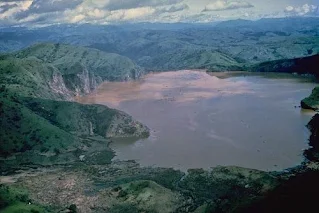Cameroon Lake Nyos Deadly Lake
Mt. Cameroon is about 4,095 meters in height last erupting in the year 2000. Mt. Cameroon is the most frequently active volcano in West Africa. Lake Nyos is a dangerous lake in Northwest Cameroon that tragically released a huge cloud of lethal carbon dioxide on August 21, 1986, killing 1,800 sleeping African villagers. Lake Nyos is a lethal carbon dioxide gas rich water-filled crater of a volcano.
 |
| Lake Nyos is a naturally gas-rich lake. |
Cameroon Lake Nyos is a naturally gas-rich deadly lake. Read about the Cameroon Lake Nyos Carbon Dioxide Tragedy of 1986.
The environmental disaster that occurred at Lake Nyos, Cameroon is one of the most destructive carbon dioxide natural disasters in modern times. This is due to Lake Nyos being a naturally gas-rich lake. Lake Nyos, Cameroon is one of the most destructive carbon dioxide natural disasters in modern times. It has been 28 years since the tragedy at Lake Nyos and the Cameroon Lake is still at dangerous Carbon Dioxide levels.
The Cameroon line is a 994-mile or 1,600 km chain of volcanoes. The oldest rocks have been dated at 70 million years old. Nine volcanoes along the line are active. A fissure eruption occurred at Mt. Cameroon in 1982. Lake Nyos is a water-filled crater of an old volcano, deep and funnel-shaped.
In Cameroon, West Africa on August 21, 1986 Lake Nyos, belched a lethal carbon dioxide gas because a landslide disturbed the lake. At least 1,800 people died and in one village, everyone was killed. Most of the victims died in their sleep of carbon dioxide poisoning. The gas killed all living things within a 15 mile or 25km radius of the lake.
The signs of asphyxiation are similar to strangulation, as like being gassed by a kitchen stove. The tragedy happened at Lake Nyos, about 200 miles or 322 km northwest of the capital, Yaoundé, during the night.
The lake's lower levels became flooded by carbon dioxide gas due to gaseous springs, which bubbled up from the extinct volcano beneath. Carbon dioxide is denser than air, the massive bubble of carbon dioxide gas hugged the ground and flowed down the stream like fog. Sadly, many villagers were in the carbon dioxide fog’s path and were killed.
The auto-siphon project began in 2001 by scientists from the United States, France and Cameroon. Pipes have now been put in place in Lake Nyos to siphon water from the lower layers up to the surface and allow the carbon dioxide at the bottom of the lake to slowly bubble out, avoiding a repeat of the August 21, 1986 Lake Nyos catastrophe. The very long pipes eject 90 percent carbon dioxide and 10 percent water. Lake Nyos is slowly being degassed but it is still dangerous.
It has been 28 years since the tragedy at Lake Nyos and the Cameroon Lake is still at dangerous Carbon Dioxide levels.
Did you know? Lake Nyos is a dangerous lake in Northwest Cameroon which tragically released a huge cloud of lethal carbon dioxide on August 21st, 1986, killing 1,800 sleeping African villagers and 3,500 of their livestock.

 Since 2007
Since 2007




